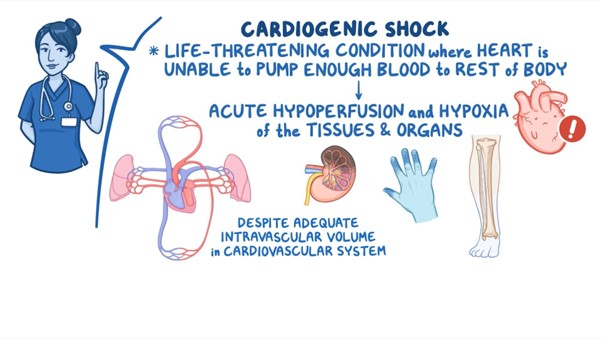Which of the following interventions is considered a priority when treating a patient who presents with septic shock?
obtaining wound and blood
removing or controlling potentially infected sources
initiation of an intravenous line and fluid
drawing blood for hematology and chemistry studies
The Correct Answer is C
Septic shock is a life-threatening condition characterized by severe infection, systemic inflammation, and inadequate tissue perfusion. In this critical situation, one of the initial priorities is to restore intravascular volume and improve tissue perfusion. Initiation of an intravenous line allows for the administration of fluids and other necessary medications to support the patient's hemodynamic stability.
While the other interventions mentioned are also important components of septic shock management, the immediate priority is to address hypotension and tissue hypoperfusion through fluid resuscitation:
A. Obtaining wound and blood cultures in (option A) is incorrect because: Cultures are important to identify the source and causative organisms of the infection. However, fluid resuscitation should take priority over obtaining cultures, as it is necessary to stabilize the patient's hemodynamics.
B. Removing or controlling potentially infected sources in (option B) is incorrect because: Identifying and controlling the source of infection is crucial in septic shock management to prevent further progression. However, initiating fluid resuscitation is more time-sensitive and should be prioritized.
D. Drawing blood for hematology and chemistry studies in (option D) is incorrect because Laboratory studies are important for evaluating organ function and guiding treatment. However, the immediate focus should be on fluid resuscitation to address the underlying hypoperfusion and stabilize the patient's condition.
Therefore, the intervention considered a priority when treating a patient who presents with septic shock is the initiation of an intravenous line and fluid administration to restore intravascular volume and improve tissue perfusion.
Nursing Test Bank
Naxlex Comprehensive Predictor Exams
Related Questions
Correct Answer is D
Explanation
In septic shock, prompt administration of antibiotics is crucial in order to target the underlying infection and prevent further progression of the septic process. Antibiotics help to eradicate the causative organisms and reduce the bacterial load, which can help improve patient outcomes.
While all the options mentioned are important interventions in the management of septic shock, initiating antibiotic therapy is considered a priority in order to address the underlying infection and prevent sepsis-related complications.
A. Giving a 2000 mL normal saline bolus in (option A) is incorrect because: Fluid resuscitation is important in septic shock to restore intravascular volume, but antibiotic therapy takes precedence as it directly targets the underlying infection.
B. Starting an insulin drip to maintain blood glucose at 110 to 150 mg/dL in (option B) is incorrect because Glycemic control is important in septic shock, but it is not the first priority compared to addressing the infection.
C. Giving acetaminophen (Tylenol) 650 mg rectally in (option C) is incorrect because Antipyretic medications can help reduce fever, but they do not address the underlying infection or stabilize the patient's condition.
E. Starting norepinephrine (Levophed) to keep systolic blood pressure >90 mm Hg in (option E) is incorrect because: Vasopressor support may be necessary in septic shock to maintain adequate blood pressure, but initiating antibiotics takes priority in order to address the underlying infection.
Therefore, in a patient with septic shock presenting with the given signs and symptoms, the nurse should first implement the intervention of giving the prescribed antibiotics to target the underlying infection.
Correct Answer is ["A","B","D","E"]
Explanation
A. Narrowed pulse pressure: In cardiogenic shock, the cardiac output is compromised, resulting in reduced stroke volume and subsequent narrowed pulse pressure. The pulse pressure is the difference between systolic and diastolic blood pressure.
B. Tachycardia: Tachycardia is a compensatory response in cardiogenic shock, as the body attempts to increase cardiac output to maintain tissue perfusion despite decreased stroke volume. Increased heart rate is a common finding in this condition.
D. Pulmonary congestion: Cardiogenic shock is often associated with impaired left ventricular function, leading to an inadequate pump mechanism. This can result in fluid accumulation and congestion in the pulmonary circulation, leading to pulmonary edema and congestion. Patients may experience symptoms such as dyspnea, crackles on lung auscultation, and increased work of breathing.
E. Elevated pulmonary artery wedge pressure (PAWP): PAWP is a measurement obtained during invasive hemodynamic monitoring. In cardiogenic shock, the impaired left ventricular function leads to increased left atrial pressure, which is reflected by an elevated PAWP. Elevated PAWP indicates increased fluid volume and congestion in the left side of the heart.
C. Elevated SBP in (option C) is incorrect because Elevated systolic blood pressure (SBP) is not a typical finding in cardiogenic shock. Instead, hypotension or decreased blood pressure is commonly observed due to reduced cardiac output.

Whether you are a student looking to ace your exams or a practicing nurse seeking to enhance your expertise , our nursing education contents will empower you with the confidence and competence to make a difference in the lives of patients and become a respected leader in the healthcare field.
Visit Naxlex, invest in your future and unlock endless possibilities with our unparalleled nursing education contents today
Report Wrong Answer on the Current Question
Do you disagree with the answer? If yes, what is your expected answer? Explain.
Kindly be descriptive with the issue you are facing.
